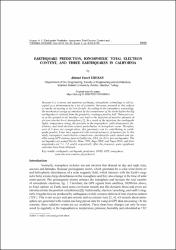Earthquake Prediction, Ionospheric Total Electron Content, and Three Earthquakes in California
Abstract
Because it is a newer and unproven technique, ionospheric seismology is still accepted as a phenomenon by a lot of scientists. However, research in this subject is rapidly increasing in the last decade. According to the ionospheric seismology, the mechanical energy accumulated by the compression of the rocks before the big earthquakes is released from the ground by creating a positive hall. These processes at the ground-to-air interface can lead to the injection of massive amounts of air ions into the lower atmosphere [1]. As a result of the injection, the earthquake lights, temperature rising, the pressure in the troposphere, radio frequencies distortions, and total electron content perturbation in ionosphere occur. Therefore, even if it does not enough alone, this parameter can be contributing to earthquake predict. It has been supported with several instances of manuscript. In this study, ionospheric total electron content was calculated for each station and satellite using GPS stations data in California, USA, for three last earthquakes. The earthquakes are named Hector Mine-1999, Baja-2009, and Napa-2014, and their magnitudes are 7.1, 7.2, and 6, respectively. After the processes, quite significant outcomes have been obtained.
Volume
23Collections
The following license files are associated with this item:


















